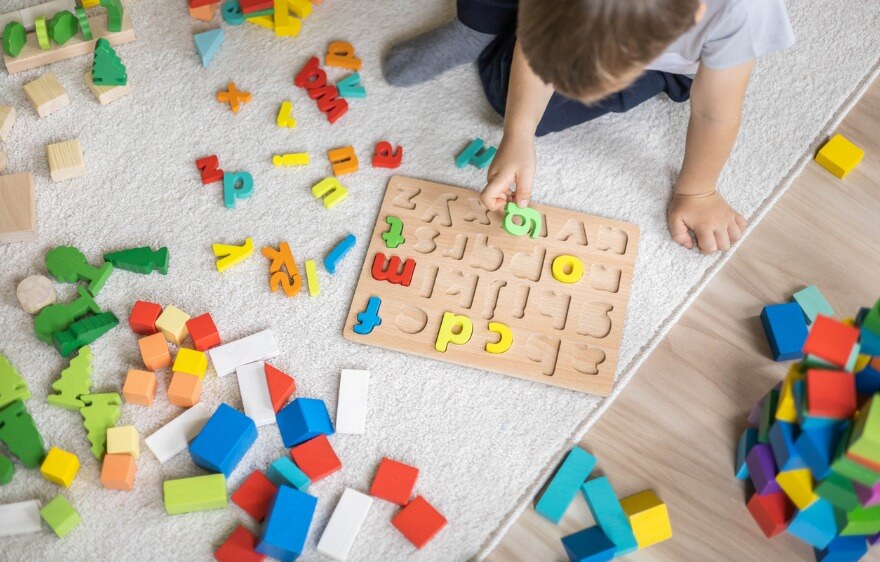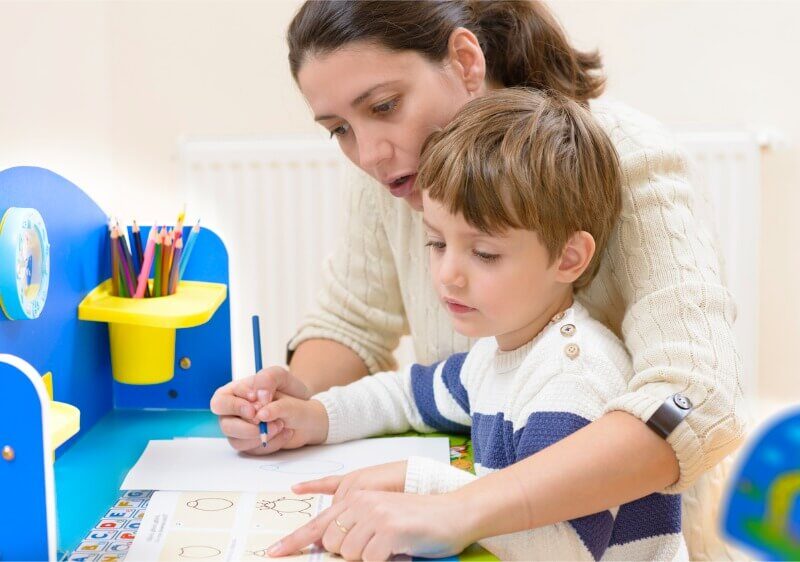Let’s help kiddos conquer some speech therapy goals! Speech therapy helps kids overcome challenges with speech, language, communication, and swallowing disorders. But you can’t achieve those speech therapy goals if they’re not realistic. Making achievable goals isn’t just essential — it makes the journey more exciting! Let’s explore these 10 important speech therapy goals, packed with examples and tips. Let’s turn challenges into triumphs, one goal at a time!
10 Examples of Speech Therapy Goals
1. Improve Articulation
Sample Goals:
- Correct the production of the /r/ sound in all word positions.
- Produce the /s/ sound accurately in sentences.
- Achieve clear articulation of the /th/ sound in conversation.
- Eliminate the substitution of /w/ for /r/ in words.
- Produce multisyllabic words correctly without omitting sounds.
Clear articulation is crucial for being understood by others. Misarticulation can lead to communication breakdowns and frustration. Improving articulation enhances a child’s intelligibility and confidence in speaking.
Recommendations:
- Use phonetic placement techniques.
- Practice with visual and tactile cues.
- Incorporate articulation drills into fun activities.
2. Enhance Expressive Language
Sample Goals:
- Use complete sentences to describe a picture.
- Expand sentence length to at least six words.
- Use appropriate tense in sentences.
- Formulate questions independently in conversation.
- Use descriptive words to elaborate on ideas.
Expressive language skills are essential for sharing thoughts, ideas, and needs. Limited expressive language can restrict a child’s ability to interact socially and academically. Enhancing these skills fosters better communication and social interactions.
Recommended Activities:
- Model complete sentences during play.
- Use sentence expansion activities.
- Provide opportunities for the child to describe daily activities.
3. Increase Vocabulary
Sample Goals:
- Learn and use 10 new words related to a specific category (e.g., animals, foods).
- Use age-appropriate vocabulary in sentences.
- Identify and name objects in the environment.
- Understand and use antonyms and synonyms.
- Apply new vocabulary in storytelling.
A rich vocabulary is essential for effective communication and academic success. Limited vocabulary can hinder a child’s ability to understand and express themselves. Increasing vocabulary helps children communicate more precisely and understand more complex language.
Recommendations:
- Use themed picture books and flashcards.
- Incorporate new words into daily routines.
- Practice naming and categorizing objects.
4. Improve Receptive Language
Sample Goals:
- Follow three-step directions independently.
- Answer questions about a short story accurately.
- Understand and follow classroom instructions.
- Identify objects based on their description.
- Respond appropriately to “wh” questions (who, what, where, when, why).
Receptive language skills are crucial for understanding spoken language and following directions. Difficulties with receptive language can impact learning and social interactions. Enhancing receptive language helps children comprehend instructions and engage more effectively in their environments.
Recommendations:
- Give clear, concise instructions.
- Use visual aids and gestures.
- Practice following directions through games and activities.
5. Enhance Social Communication
Sample Goals:
- Initiate and maintain a conversation for at least five turns.
- Use appropriate greetings and closings in interactions.
- Understand and use nonverbal communication cues.
- Take turns appropriately during a conversation.
- Stay on topic during discussions.
Social communication skills are essential for building relationships and interacting in social settings. Difficulties in this area can lead to social isolation and misunderstandings. Enhancing social communication helps children interact more successfully with peers and adults.
Recommended Activities:
- Practice conversation starters and turn-taking.
- Use role-playing activities.
- Provide visual supports to guide conversations.
6. Improve Fluency
Sample Goals:
- Reduce stuttering occurrences by 50% during conversation.
- Use smooth speech techniques during structured activities.
- Speak fluently during a 5-minute conversation.
- Use strategies to manage moments of stuttering.
- Maintain fluency while reading aloud.
Fluency is essential for smooth and effective communication. Stuttering can cause frustration and anxiety, impacting a child’s willingness to speak. Improving fluency helps children communicate more confidently and reduces the emotional impact of stuttering.
Recommended Activities:
- Teach slow and easy speech techniques.
- Use fluency-shaping strategies.
- Provide a supportive and relaxed speaking environment.
7. Enhance Phonological Awareness
Sample Goals:
- Identify and produce rhyming words.
- Segment words into individual sounds.
- Blend sounds to form words.
- Identify the beginning, middle, and ending sounds in words.
- Manipulate sounds within words (e.g., change “cat” to “bat”).
Phonological awareness is a key precursor to reading and writing skills. Difficulties in this area can lead to challenges with literacy. Enhancing phonological awareness helps children develop strong foundational skills for reading and spelling.
Recommended Activities:
- Use rhyming games and songs.
- Practice with rhyming picture cards.
- Read books with rhyming text.
8. Increase Mean Length of Utterance (MLU)
Sample Goals:
- Use sentences with an average of five words.
- Combine two ideas into one sentence.
- Use compound sentences in conversation.
- Increase sentence length in spontaneous speech.
- Expand utterances to include adjectives and adverbs.
Increasing MLU is important for more complex and detailed communication. Short, simple utterances can limit a child’s ability to express themselves fully. Enhancing MLU helps children communicate more effectively and participate in more complex conversations.
Recommendations:
- Encourage the child to expand on their responses.
- Model longer sentences during interactions.
- Use language expansion techniques.
9. Improve Pragmatic Skills
Sample Goals:
- Use appropriate eye contact during conversations.
- Understand and follow conversational rules.
- Interpret and use nonverbal signals.
- Adjust language based on the listener and context.
- Recognize and repair communication breakdowns.
Pragmatic skills are crucial for effective social communication and understanding social norms. Difficulties in this area can lead to social misunderstandings and isolation. Improving pragmatic skills helps children navigate social interactions more successfully.
Recommended Activities:
- Teach the importance of eye contact.
- Use social stories and visual supports.
- Practice through role-playing and video modeling.
10. Enhance Speech Intelligibility
Sample Goals:
- Increase overall speech intelligibility to 90%.
- Produce consonant clusters clearly in words.
- Reduce the occurrence of sound omissions in speech.
- Improve vowel articulation for clearer speech.
- Speak at an appropriate rate for better understanding.
Speech intelligibility is essential for being understood by others. Poor intelligibility can lead to communication breakdowns and frustration. Improving intelligibility helps children communicate more effectively and reduces misunderstandings.
Recommended Activities:
- Focus on clear articulation of sounds.
- Use pacing boards and visual cues.
- Incorporate speech exercises into everyday activities.
Setting SMART Speech Therapy Goals
Be Specific: Clearly define what you want to achieve. For example, “Use complete sentences to describe a picture” is more specific than “Improve expressive language.”
Make Goals Measurable: Ensure progress can be tracked with quantifiable measures, such as frequency of stuttering occurrences or the number of new words learned.
Set Achievable Goals: Goals should be realistic based on the child’s current abilities and potential for improvement.
Be Relevant: Align goals with the child’s personal needs, interests, and daily activities.
Time-Bound: Establish a timeline for achieving each goal to maintain motivation and track progress.
Our Therapists Smash Their Speech Therapy Goals
Speech therapy is a goal-driven process filled with dedication, persistence, and compassion. At Care Options for Kids, we provide our speech-language pathologists with the resources and support they need to help their kiddos meet their milestones! Within a collaborative and nurturing environment, our therapists provide personalized therapy that addresses the unique needs of each child. This ensures our therapists are fulfilled, and their kiddos meet their speech therapy goals. Want to be part of a team that smashes their speech therapy goals?
Join the Care Options For Kids Team!
Are you ready for meaningful work that comes with benefits and not burnout? Join the compassionate care team that helps children and families live their best lives. Our clinicians provide best-in-class pediatric nursing, therapy, and school-based services. We bring individualized care to children where they live, work, and play. We have opportunities in homes, schools, and clinics across the country.
Apply at Care Options for Kids now. We make it easy to start so you can make a difference as soon as possible.
This post is for educational and informational purposes only. You should always speak with your own therapist before implementing this information on your own.






